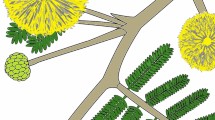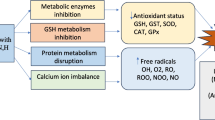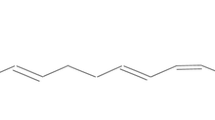Abstract
Pregnant Charles River CD1 mice were treated with a semipurified extract ofFusarium moniliforme culture containing 0, 12.5, 25, 50 or 100 mg FB1/kg each day orally (diluted in distilled water) between gestational days (GD) 7 and 15 to evaluate the developmental toxicity of FB1. Following sacrifice of dams on GD 18, litters were examined for gross abnormalities and divided equally for skeletal or visceral examination by routine techniques. Significant maternal mortality was observed at doses of 50 and 100 mg FB1/kg. Dose-dependant decreases in maternal body weight gains, number of live offsprings per litter, and mean body weight of the offspring were produced at FB1 doses of 25 mg/kg or higher. The percentage of implants resorbed increased at all doses in a dose-dependant manner. A dose-dependant increase, except at the lowest dose tested, in the incidence of ossification deficits involving digits and sternum, short and wavy ribs, and hydrocephalus of lateral and third ventricles was also evident. Cleft palate was seen only at the highest FB1 dose. Maternal intoxication manifested as a dose-dependant increase in the severity of ascites associated mainly with increased histopathologic scores reflecting hepatocellular damage at day 18. Concommittant increases in serum alanine amino transferase (ALT) on GD 12, reflecting parenchymal liver cell damage, was also observed at all doses above 12.5 mg of FB1/kg. These results suggest that FB1-containingF. moniliforme culture extract is developmentally toxic in mice, and that this toxicity may be mediated by maternal hepatotoxicity.
Similar content being viewed by others
References
Thiel PG, Marasas WFO, Sydenham E, Sheppard GS, Gelderblom WCA. The implications of naturally occurring levels of fumonisins in corn for human and animal health. Mycopathologia 1992; 117: 3–9.
Ross PF, Rice LG, Osweiler GD, Nelson PE, Richard JL, Wilson TM. A review and update of animal toxicoses associated with fumonisin-contaminated feeds and production of fumonisins byFusarium isolates. Mycopathologia 1992; 117: 109–14.
Kriek NPJ, Marasas WFO, Thiel PG. Hepato- and cardiotoxicity ofFusarium verticilloides (F. moniliforme) isolates from southern African maize. Fd Cosmet Toxicol 1981; 19: 447–56.
Hasehek WM, Motelin G, Ness DK, Harlin KS, Hall WF, Vesonder RF, Peterson RE, Beasley Val R. Characterization of fumonisin toxicity in orally and intravenously dosed swine. Mycopathologia 1992; 117: 83–96.
Harrison LR, Colvin BM, Greene JT, Newman LE, Cole Jr. JR. Pulmonary edema and hydrothorax in swine produced by fumonisin B1, a toxic metabolite ofFusarium moniliforme. J Vet Diag Invest 1990; 2: 217–21.
Jaskiewicz K, van Rensburg SJ, Marasas WFO, Gelderblom WCA. Carcinogenicity ofFusarium moniliforme culture material in rats. J Natl Cancer Inst 1987; 78: 321–5.
Marasas WFO, Kriek NPJ, Fincham JE, Van Rensburg SJ. Primary liver cancer and oesophageal basal cell hyperplacia in rats caused byFusarium moniliforme. Intl J Cancer 1984; 34: 383–87
Wilson TM, Ross PF, Owens DL, Rice LG, Green SA, Jenkins SJ, Nelson HA. Experimental reproduction of ELEM: a study to determine the minimum toxic dose in ponies. Mycopathologia 1992; 117: 115–20.
Marasas WFO, Jaskiewicz K, Venter FS, Van Schalkwyk DJ.Fusarium moniliforme contamination of maize in esophageal cancer areas in Transkei. S Afr Med J 1988; 74: 110–14.
Floss JL, Casteel, SW, Johnson GC, Rottinghaus GE. Developmental toxicity in hamsters of an aqueous extract ofFusarium moniliforme culture material containing known quantities of fumonisin B1. Vet Hum Toxicol 1994; 36: 5–10.
Plattner RD, Norred WP, Bacon CW, Voss KE, Peterson R, Shakelford DD, Weisleder D. A method of detection of fumonisins in corn samples associated with field cases of equine leukoencephalomalacia. Mycopathologia 1990; 82: 698–702.
Wilson TM, Ross PF, Rice LG, Osweiler GD, Nelson HA, Owens DL, Platter RD, Reggierdo C, Noon TH, Pickerell JW. Fumonisin B1 levels associated with an epizootic of equine leukoencephalomalacia. J Vet Diag Invest 1990; 2: 213–16.
Wilson G. Methods for administering agents and detecting malformations in experimental animals. In Wilson JG, Warkany J, eds.Teratology: Principles and Techniques. Chicago: University of Chicago Press, 1965: 262–77.
Blick KE, Liles SM. InPrinciples of Clinical Chemistry. New York: John Wiley & Sons, 1985: 451–52.
Voss KA, Norred WP, Bacon CW. Subchronic toxicological investigations ofFusarium moniliforme — contaminated corn, culture material and ammoniated culture material. Mycopathologia 1992; 117: 97–104.
Author information
Authors and Affiliations
Rights and permissions
About this article
Cite this article
Gross, S.M., Reddy, R.V., Rottinghaus, G.E. et al. Developmental effects of fumonisin B1-containingFusarium moniliforme culture extract in CD1 mice. Mycopathologia 128, 111–118 (1994). https://doi.org/10.1007/BF01103018
Received:
Accepted:
Issue Date:
DOI: https://doi.org/10.1007/BF01103018




